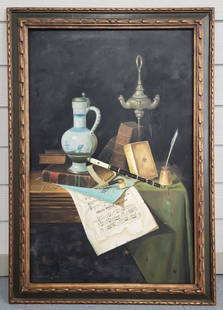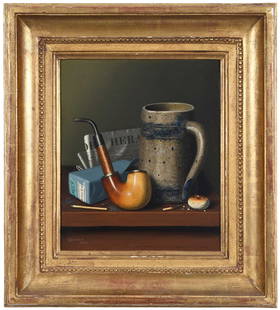


Item Details
Description
William Michael Harnett (1848-1892)
Still Life with Quill and Pipe
signed with conjoined initials and dated 'WMHarnett. / 1879.' (lower right)
oil on canvas
16 1/8 x 24 1/8 in. (41 x 61.3 cm.)
Painted in 1879.
Footnotes:
Provenance
Private collection, New Jersey.
Estate of the above.
Peter Jung Gallery, Hudson, New York, acquired from the above, circa 2018.
Acquired by the present owner from the above.
The present work is a consummate example of William Michael Harnett's trompe l'oeil compositions of the late 1870s that beautifully demonstrates the artist's mastered approach to the illusionistic painting technique. Arranged seemingly naturally atop a table, Harnett depicts in painstaking detail a tankard embossed with medieval figures with the stern of a pipe resting in the crook of its broken handle, an inked quill whose fragile tip idles gently on a pile of handwritten letters, a vessel filled with matches crowning a stack of books, one of which is titled WORDSWORTH WORKS on its binding, and a brass candlestick holder. The glow of the dying embers visible inside the pipe's chamber lures the viewer's gaze, while the rising smoke and diagonal placement of both the pipe and quill direct attention to the other objects that makeup the composition. The ash and the matches that have been stricken that cover the table, along with the candlestick burned nearly to its end create the impression that the viewer has just entered a study at the end of an apparently long day of work and that its former occupant has just left the room.
The inventory of objects Harnett populates his still life paintings of the late 1870s with are significant in their power to speak on themes of routines, intellectual exchanges, commerce, and modes of relaxation in America during the period. In discussing Harnett's imagery, Professor John Wilmerding argues, 'Decisively shifting from the imagery of Raphaelle Peale's fruit compositions, John F. Francis's dessert tables, and Severin Rosen's flower bouquets, Harnett, virtually alone, introduced an imagery for a post-Darwinian world, a turbulent America in the strains of Reconstruction, industrial growth, and political and financial corruption. Nature's bounty was now exchanged for material possessions and wealth. Contemplation of the expansive landscape yielded to concentration on the private corners of the desk and study.' (D. Bolger, M. Simpson, J. Wilmerding, eds., William M. Harnett, exhibition catalogue, New York, 1992, p. 149)
In the present work, the letters and quill invoke the theme of intellectual exchanges, reflecting both the Victorian tradition of writing letters and the importance placed on the communication of information and ideas during this period. Furthermore, the books arranged on the table allude to the broadening literacy of the population. Though the pipe is arguably interpreted as an instrument of pleasure and relaxation, it also cleverly invokes the theme of commerce for its ties to the tobacco industry, one of the largest industries in America at the time being introduced to substantial improvements in mechanical production. Similar attributes reflecting intellectual exchange and commerce in America can be found in Harnett's other notable still life trompe l'oeil compositions produced during this period, such as in The Banker's Table (1877, The Metropolitan Museum of Art, New York), American Exchange (1878, Detroit Institute of Arts, Michigan), and Secretary's Table (1879, Santa Barbara Museum of Art, California).
While this group of Harnett's trompe l'oeil compositions of the late 1870s observe the sociological and economic concerns of America at this time, professor Nika Elder also proposes that the absent figure that these vignettes evoke ties to our understanding of selfhood and consciousness that emerged in this era. Elder goes on to argue, 'Objects casually strewn on tabletops offered Harnett a way to bypass the body and depict cognition itself. He does not picture people thinking, reading, writing, or counting; instead he depicts texts, quills and inkwells, and money in order to evoke the operations on which these activities rest. Going one step further than nineteenth century portraits, then, Harnett's early tabletop still lifes represent consciousness without locating it in the human body. (N. Elder, William Harnett's Curious Objects: Still-Life Painting after the American Civil War, Oakland, California, 2022, pp. 68-69) While these objects arguably represent the routines, occupations, and intellectual pursuits of the period, they also represent the human mind at work and the ambitions of the human spirit in an advancing America after the Civil War.
Still Life with Quill and Pipe
signed with conjoined initials and dated 'WMHarnett. / 1879.' (lower right)
oil on canvas
16 1/8 x 24 1/8 in. (41 x 61.3 cm.)
Painted in 1879.
Footnotes:
Provenance
Private collection, New Jersey.
Estate of the above.
Peter Jung Gallery, Hudson, New York, acquired from the above, circa 2018.
Acquired by the present owner from the above.
The present work is a consummate example of William Michael Harnett's trompe l'oeil compositions of the late 1870s that beautifully demonstrates the artist's mastered approach to the illusionistic painting technique. Arranged seemingly naturally atop a table, Harnett depicts in painstaking detail a tankard embossed with medieval figures with the stern of a pipe resting in the crook of its broken handle, an inked quill whose fragile tip idles gently on a pile of handwritten letters, a vessel filled with matches crowning a stack of books, one of which is titled WORDSWORTH WORKS on its binding, and a brass candlestick holder. The glow of the dying embers visible inside the pipe's chamber lures the viewer's gaze, while the rising smoke and diagonal placement of both the pipe and quill direct attention to the other objects that makeup the composition. The ash and the matches that have been stricken that cover the table, along with the candlestick burned nearly to its end create the impression that the viewer has just entered a study at the end of an apparently long day of work and that its former occupant has just left the room.
The inventory of objects Harnett populates his still life paintings of the late 1870s with are significant in their power to speak on themes of routines, intellectual exchanges, commerce, and modes of relaxation in America during the period. In discussing Harnett's imagery, Professor John Wilmerding argues, 'Decisively shifting from the imagery of Raphaelle Peale's fruit compositions, John F. Francis's dessert tables, and Severin Rosen's flower bouquets, Harnett, virtually alone, introduced an imagery for a post-Darwinian world, a turbulent America in the strains of Reconstruction, industrial growth, and political and financial corruption. Nature's bounty was now exchanged for material possessions and wealth. Contemplation of the expansive landscape yielded to concentration on the private corners of the desk and study.' (D. Bolger, M. Simpson, J. Wilmerding, eds., William M. Harnett, exhibition catalogue, New York, 1992, p. 149)
In the present work, the letters and quill invoke the theme of intellectual exchanges, reflecting both the Victorian tradition of writing letters and the importance placed on the communication of information and ideas during this period. Furthermore, the books arranged on the table allude to the broadening literacy of the population. Though the pipe is arguably interpreted as an instrument of pleasure and relaxation, it also cleverly invokes the theme of commerce for its ties to the tobacco industry, one of the largest industries in America at the time being introduced to substantial improvements in mechanical production. Similar attributes reflecting intellectual exchange and commerce in America can be found in Harnett's other notable still life trompe l'oeil compositions produced during this period, such as in The Banker's Table (1877, The Metropolitan Museum of Art, New York), American Exchange (1878, Detroit Institute of Arts, Michigan), and Secretary's Table (1879, Santa Barbara Museum of Art, California).
While this group of Harnett's trompe l'oeil compositions of the late 1870s observe the sociological and economic concerns of America at this time, professor Nika Elder also proposes that the absent figure that these vignettes evoke ties to our understanding of selfhood and consciousness that emerged in this era. Elder goes on to argue, 'Objects casually strewn on tabletops offered Harnett a way to bypass the body and depict cognition itself. He does not picture people thinking, reading, writing, or counting; instead he depicts texts, quills and inkwells, and money in order to evoke the operations on which these activities rest. Going one step further than nineteenth century portraits, then, Harnett's early tabletop still lifes represent consciousness without locating it in the human body. (N. Elder, William Harnett's Curious Objects: Still-Life Painting after the American Civil War, Oakland, California, 2022, pp. 68-69) While these objects arguably represent the routines, occupations, and intellectual pursuits of the period, they also represent the human mind at work and the ambitions of the human spirit in an advancing America after the Civil War.
Buyer's Premium
- 28% up to $50,000.00
- 27% up to $1,000,000.00
- 21% above $1,000,000.00
William Michael Harnett (1848-1892) Still Life with Quill and Pipe 16 1/8 x 24 1/8 in. (41 x 61....
Estimate $50,000 - $70,000
Starting Price
$40,000
6 bidders are watching this item.
Get approved to bid.
Shipping & Pickup Options
Item located in New York, NY, USSee Policy for Shipping
Payment

American Art
New York, NY, USA
Related Paintings
More Items from William Michael Harnett
View MoreRecommended Art
View MoreTOP









































































